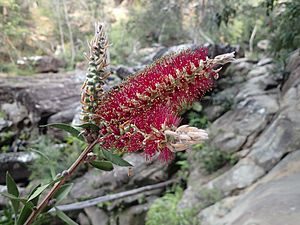Tapering-leaved bottlebrush facts for kids
Quick facts for kids Tapering-leaved bottlebrush |
|
|---|---|
 |
|
| Melaleuca flammea leaves and flowers | |
| Scientific classification | |
| Genus: |
Melaleuca
|
| Species: |
flammea
|
| Synonyms | |
|
Callistemon acuminatus Cheel |
|
Melaleuca flammea, also known as the tapering-leaved bottlebrush, is a cool plant from the myrtle family. You can find it only in New South Wales and Queensland in Australia. (Some plant experts still call it Callistemon acuminatus.) This shrub has wide, spear-shaped leaves with wavy edges. They slowly get narrower to a sharp point. In spring, it grows amazing bottlebrush flowers. Their bright, fiery color gives the plant its name!
Contents
What Does It Look Like?
Melaleuca flammea is a shrub that can grow from about 1 to 5 meters (3 to 16 feet) tall. It has tough, stringy bark. Its leaves grow one after another along the stem. They are long, from 36 to 151 millimeters (1.4 to 5.9 inches) in length. They are also 6 to 31 millimeters (0.24 to 1.2 inches) wide. The leaves are shaped like a spear and slowly get narrower to a fine point. They also have a wide V-shape and wavy edges. You can see 12 to 33 clear veins on the leaves.
The Fiery Flowers
The flowers are deep red to crimson. They grow in spikes at the ends of branches. These branches keep growing even after the flowers bloom. The flower spikes are up to 70 millimeters (2.8 inches) across. Each spike has 25 to 120 individual flowers. The petals are 3 to 5.4 millimeters (0.12 to 0.21 inches) long. They fall off as the flower gets older. Each flower has 20 to 32 bright red stamens. Stamens are the parts that hold the pollen.
When It Blooms
This plant mainly flowers in spring. But you can often see it blooming at other times of the year too. After flowering, it produces woody capsules. These are like small, hard seed pods. They are 3.9 to 5.5 millimeters (0.15 to 0.22 inches) long.
How It Got Its Name
Melaleuca flammea was first officially named in 2006. This was done by a scientist named Lyndley Craven. Before that, in 1911, another scientist, Edwin Cheel, had described it as Callistemon acuminatus. He found a sample of the plant near the Crawford River in New South Wales.
Meaning of the Name
The plant's special name, flammea, comes from a Latin word. Flammeus means "fiery" or "fiery-red." This name perfectly describes the bright, fiery color of the plant's stamens.
Where It Grows
You can find Melaleuca flammea in a few places. It grows near Nambour in Queensland. It also grows along the coast of New South Wales. This area stretches from Port Stephens to the Clarence River area. It usually grows in woodlands or forests. You'll often find it on dry, rocky hilltops.
Is It Protected?
In New South Wales, Melaleuca flammea (when called Callistemon acuminatus) is listed as a "Rare or Threatened Australian Plant." This means it's a special plant that needs protection.
Growing It in Gardens
This plant is not very common in gardens. However, it is a tough plant. It can handle frost and dry weather well. Its unique leaves and big, brightly colored flowers make it a great plant for gardens. It has good potential for people who like to grow native plants.


